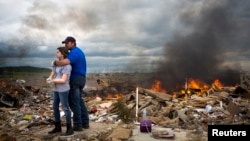Hundreds of government representatives, local authorities, the private sector, and civil society will gather to begin work on a new global agreement on Disaster Risk Reduction next week at the United Nations in Geneva. The meeting will lay the groundwork for the Third U.N. World Conference on Disaster Risk Reduction next March in Sendai, Japan.
The new agreement will replace the existing Hyogo Framework for Action, which was adopted by all U.N. Member States in 2005 following the Indian Ocean tsunami that killed nearly one-quarter of a million people.
The United Nations estimates natural disasters and hazards in the past 20 years have affected four billion people, claiming 1.3 million lives, with a cost of around two trillion dollars in economic losses.
The Head of the U.N. Office for Disaster Risk Reduction, Margareta Wahlstrom, said the single biggest success of the Hyogo agreement has been in lives saved through the enactment of preparedness plans, such as early warning systems. But she said that agreement has run its course.
“It is very clear that a new updated agreement is required just because of the economic losses, the rapid urbanization and increasing wealth of the world. At the same time, many other new actors, because of the economic losses, the private sector has a big focus on this as well," said Wahlstrom.
The United Nations estimates economic losses from natural disasters have been running at more than $100 billion a year during the past decade.
Thailand is one of many countries with huge expenses from rebuilding after a natural disaster.
U.N. Ambassador from Thailand and co-chair of the Preparatory Committee, Thani Thongphakdi, says it will cost about $50 billion to rebuild factories and other vital structures that were damaged or destroyed during major floods in 2011. He said 90 percent of that cost will be borne by the private sector.
“The private sector has to see this not as a cost, but as an investment for their own interest to ensure that they can remain resilient when the next disaster strikes. We cannot prevent natural disasters from occurring, but we can ensure resilience against them," said Thongphakdi.
"We can reduce the risks. We can ensure that factories are built upon land in areas, which are protected from flood. We can ensure through regulation incentives provided to the private sector that they invest in such preventive measures," he said.
The Thai Ambassador said the role of the private sector is one key issue that has to be addressed in the new Framework for Action II. He said the new agreement also must include measures to help local communities better prepare for disasters.
He said monitoring systems have to be strengthened and particular attention must be paid to protect at risk groups, such as women, children and the disabled from natural disasters.








